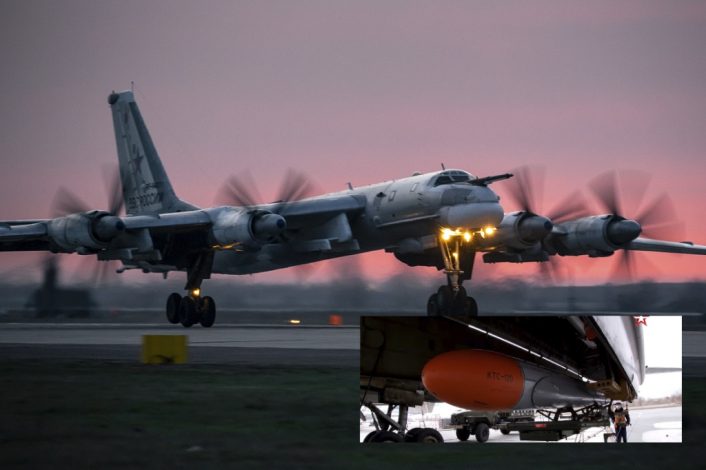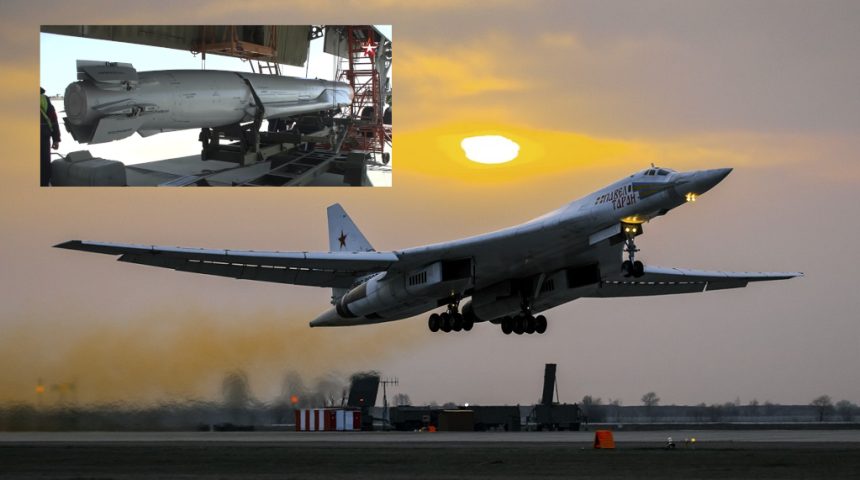Both the Russian Aerospace Forces Tu-95MS “Bear H” and the Tu-160 “Blackjack” launched Kh-555 cruise missiles at a range in the Komi Republic.
The Long-range Aviation Command of the Russian Air and Space Force conducted a command-staff exercise as part of the routine winter training, according to the Russian Ministry of Defence. Notably, the exercise included the launch of cruise missiles from its Tu-95MS “Bear H” and Tu-160 “Blackjack” bombers. This exercise is one of the many disclosed during the recent surge of Russian Military activity across the entire country and especially in the Black Sea region.
About ten aircraft, including the Tu-95MSs, Tu-160s and their supporting Il-78 “Midas” tankers, flew from the Saratov region to a range in the Komi Republic, in northwestern Russia, west of Urals, where they struck ground targets with the cruise missiles, returning to their base after more than 7 hours. The mission included “[air-to-air] refueling at an altitude of more than 6,000 meters [about 19,700 ft] and a speed of about 600 kilometers per hour [about 320 kts], as well as air patrolling in a given zone”.
Aerial exercises in the Saratov region, via @mod_russia pic.twitter.com/X7IfySVC4g
— UAC Russia (@UAC_Russia_eng) April 19, 2021
Although not mentioned in the statement from the MoD, the bombers involved should belong to the Bomber Regiments based at Engels airbase, which is in fact in the Saratov region, while the unspecified range should be the Pemboy range, which is in fact in the Komi Republic about 60 kilometers from Vorkuta. The same range was also used in 2019 to perform the first test of the Kh-47M2 Kinzhal Hypersonic Missile in the Barents Sea region.
As for the cruise missiles, the MoD published a video from this exercise showing inert Kh-555 missiles being loaded in the bomb bays of both the Tu-95 and the Tu-160. The Kh-555 is a conventionally armed variant of the Kh-55 (NATO reporting name AS-15 “Kent”) nuclear-tipped subsonic cruise missile, with an improved guidance system and a range of at least 2,500 km (1,350 nm), with some sources reporting it up to 3,000/3,500 km.
The missile became operational in the early 2000s and can be carried by the Tu-95 (six or 16 missiles, depending on the bomber’s version) and the Tu-160 (12 missiles). According to some sources, the Su-34 “Fullback” is also capable of carrying one Kh-555, while it is not known if the Tu-22M3 “Backfire” has been fully integrated with the missile, even if it was being tested. The Kh-555 was used during Russian strikes against ISIS ground targets in Syria in 2015.

“Surge” in military drills.
This is just one of the bombers exercises in what some analysts called a “surge” of Russian Military activity. Another notable one happened a day after the cruise missile exercise, with two Tu-160 Blackjacks performing an eight-hour mission over the Baltic Sea escorted by Su-35Ss of the Aerospace Forces and Su-27s of the Baltic Fleet’s Naval Aviation, supported by an A-50 “Mainstay” Airborne Early Warning and Control (AEW&C) aircraft.
In response, NATO’s Combined Air Operations Centre (CAOC) at Uedem (Germany) launched allied fighter aircraft from bases in Estonia, Lithuania and Poland to intercept and identify the approaching Russian aircraft as some of them were not identifiable by transponder signal and no flight plan had been filed, posing a flight safety hazard for civilian air traffic.
#NATO yesterday scrambled fighter jets from bases in Estonia, Lithuania, Poland and Denmark to intercept several Russian military aircraft over the Baltic Sea. Story: https://t.co/93H2aXtsUk pic.twitter.com/OnrlvI8q5F
— Matthias Eichenlaub (@MattEichenlaub) April 21, 2021
More precisely, NATO specified that the Russian aircraft were intercepted by German and Italian Eurofighter Typhoons from the Baltic Air Policing mission in Estonia and Lithuania, respectively, and Polish Air Force F-16Cs fighters from Poznan Air Base. In addition, the Royal Danish Air Force national air operations centre scrambled their F-16s from Skrydstrup Air Base. The bombers stayed in international airspace above the Baltic Sea and returned to mainland Russia after roughly three hours.
Russian Tu-160 over the Baltic Sea a few days ago. NATO fighters scrambled to identify the bombers are visible in the onboard video recorded from the accompanying Su-35Ss and Su-27s. https://t.co/pseGvjONP5
— Stefano D’Urso (@stedur93) April 22, 2021
These recent bomber missions do not seem to be related to the Russian buildup around Ukraine and Crimea which has caused concern among the international community. Officially, according to the Russian MoD, the buildup is due to scheduled exercises which are taking place in Crimean training ranges and the Black Sea to check the readiness of the Armed Forces.
Numerous armored and air defense units, tactical aircraft and warships have been deployed in the area, under the eyes of cellphones and social medias on the ground and Intelligence, Surveillance and Reconnaissance (ISR) and Signal Intelligence (SIGINT) aircraft in the sky. As always, disinformation and fake news are playing their part to further complicate the understanding of what is happening in the area and what we should expect in the near future.









